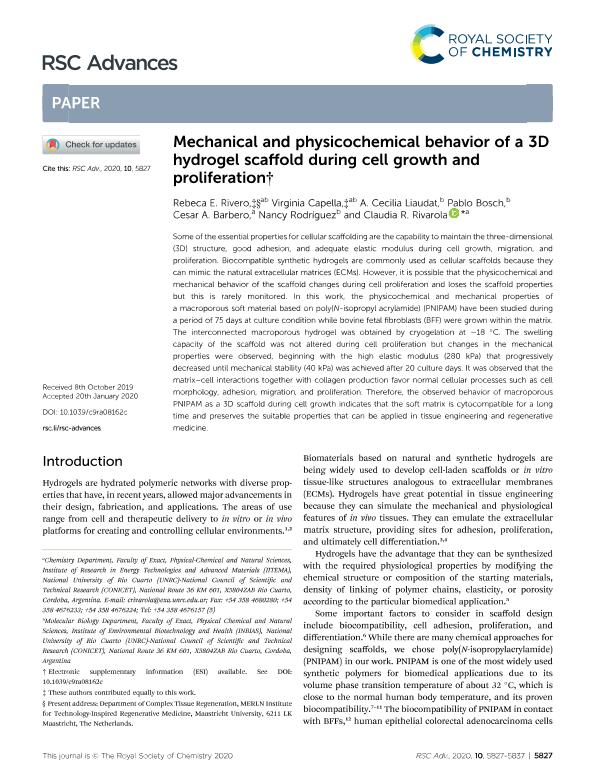Mostrar el registro sencillo del ítem
dc.contributor.author
Rivero, Rebeca Edith

dc.contributor.author
Capella, Virginia

dc.contributor.author
Liaudat, Ana Cecilia

dc.contributor.author
Bosch, Pablo

dc.contributor.author
Barbero, César Alfredo

dc.contributor.author
Rodriguez, Nancy

dc.contributor.author
Rivarola, Claudia Rosana

dc.date.available
2021-10-27T13:05:28Z
dc.date.issued
2020-02
dc.identifier.citation
Rivero, Rebeca Edith; Capella, Virginia; Liaudat, Ana Cecilia; Bosch, Pablo; Barbero, César Alfredo; et al.; Mechanical and physicochemical behavior of a 3D hydrogel scaffold during cell growth and proliferation; Royal Society of Chemistry; RSC Advances; 10; 10; 2-2020; 5827-5837
dc.identifier.issn
2046-2069
dc.identifier.uri
http://hdl.handle.net/11336/145201
dc.description.abstract
Some of the essential properties for cellular scaffolding are the capability to maintain the three-dimensional (3D) structure, good adhesion, and adequate elastic modulus during cell growth, migration, and proliferation. Biocompatible synthetic hydrogels are commonly used as cellular scaffolds because they can mimic the natural extracellular matrices (ECMs). However, it is possible that the physicochemical and mechanical behavior of the scaffold changes during cell proliferation and loses the scaffold properties but this is rarely monitored. In this work, the physicochemical and mechanical properties of a macroporous soft material based on poly(N-isopropyl acrylamide) (PNIPAM) have been studied during a period of 75 days at culture condition while bovine fetal fibroblasts (BFF) were grown within the matrix. The interconnected macroporous hydrogel was obtained by cryogelation at -18 °C. The swelling capacity of the scaffold was not altered during cell proliferation but changes in the mechanical properties were observed, beginning with the high elastic modulus (280 kPa) that progressively decreased until mechanical stability (40 kPa) was achieved after 20 culture days. It was observed that the matrix-cell interactions together with collagen production favor normal cellular processes such as cell morphology, adhesion, migration, and proliferation. Therefore, the observed behavior of macroporous PNIPAM as a 3D scaffold during cell growth indicates that the soft matrix is cytocompatible for a long time and preserves the suitable properties that can be applied in tissue engineering and regenerative medicine.
dc.format
application/pdf
dc.language.iso
eng
dc.publisher
Royal Society of Chemistry

dc.rights
info:eu-repo/semantics/openAccess
dc.rights.uri
https://creativecommons.org/licenses/by-nc/2.5/ar/
dc.subject
HYDROGEL
dc.subject
PNIPAM
dc.subject
FIBROBLASTS
dc.subject
SCAFFOLD
dc.subject.classification
Físico-Química, Ciencia de los Polímeros, Electroquímica

dc.subject.classification
Ciencias Químicas

dc.subject.classification
CIENCIAS NATURALES Y EXACTAS

dc.title
Mechanical and physicochemical behavior of a 3D hydrogel scaffold during cell growth and proliferation
dc.type
info:eu-repo/semantics/article
dc.type
info:ar-repo/semantics/artículo
dc.type
info:eu-repo/semantics/publishedVersion
dc.date.updated
2021-09-10T15:55:59Z
dc.journal.volume
10
dc.journal.number
10
dc.journal.pagination
5827-5837
dc.journal.pais
Reino Unido

dc.description.fil
Fil: Rivero, Rebeca Edith. Universidad Nacional de Río Cuarto. Facultad de Ciencias Exactas Fisicoquímicas y Naturales. Instituto de Investigaciones en Tecnologías Energéticas y Materiales Avanzados. - Consejo Nacional de Investigaciones Científicas y Técnicas. Centro Científico Tecnológico Conicet - Córdoba. Instituto de Investigaciones en Tecnologías Energéticas y Materiales Avanzados; Argentina
dc.description.fil
Fil: Capella, Virginia. Universidad Nacional de Río Cuarto. Facultad de Ciencias Exactas Fisicoquímicas y Naturales. Instituto de Biotecnología Ambiental y Salud - Consejo Nacional de Investigaciones Científicas y Técnicas. Centro Científico Tecnológico Conicet - Córdoba. Instituto de Biotecnología Ambiental y Salud; Argentina
dc.description.fil
Fil: Liaudat, Ana Cecilia. Universidad Nacional de Río Cuarto. Facultad de Ciencias Exactas Fisicoquímicas y Naturales. Instituto de Biotecnología Ambiental y Salud - Consejo Nacional de Investigaciones Científicas y Técnicas. Centro Científico Tecnológico Conicet - Córdoba. Instituto de Biotecnología Ambiental y Salud; Argentina
dc.description.fil
Fil: Bosch, Pablo. Universidad Nacional de Río Cuarto. Facultad de Ciencias Exactas Fisicoquímicas y Naturales. Instituto de Biotecnología Ambiental y Salud - Consejo Nacional de Investigaciones Científicas y Técnicas. Centro Científico Tecnológico Conicet - Córdoba. Instituto de Biotecnología Ambiental y Salud; Argentina
dc.description.fil
Fil: Barbero, César Alfredo. Universidad Nacional de Río Cuarto. Facultad de Ciencias Exactas Fisicoquímicas y Naturales. Instituto de Biotecnología Ambiental y Salud - Consejo Nacional de Investigaciones Científicas y Técnicas. Centro Científico Tecnológico Conicet - Córdoba. Instituto de Biotecnología Ambiental y Salud; Argentina
dc.description.fil
Fil: Rodriguez, Nancy. Universidad Nacional de Río Cuarto. Facultad de Ciencias Exactas Fisicoquímicas y Naturales. Instituto de Biotecnología Ambiental y Salud - Consejo Nacional de Investigaciones Científicas y Técnicas. Centro Científico Tecnológico Conicet - Córdoba. Instituto de Biotecnología Ambiental y Salud; Argentina
dc.description.fil
Fil: Rivarola, Claudia Rosana. Universidad Nacional de Río Cuarto. Facultad de Ciencias Exactas Fisicoquímicas y Naturales. Instituto de Investigaciones en Tecnologías Energéticas y Materiales Avanzados. - Consejo Nacional de Investigaciones Científicas y Técnicas. Centro Científico Tecnológico Conicet - Córdoba. Instituto de Investigaciones en Tecnologías Energéticas y Materiales Avanzados; Argentina
dc.journal.title
RSC Advances
dc.relation.alternativeid
info:eu-repo/semantics/altIdentifier/url/http://xlink.rsc.org/?DOI=C9RA08162C
dc.relation.alternativeid
info:eu-repo/semantics/altIdentifier/doi/https://doi.org/10.1039/C9RA08162C
Archivos asociados
